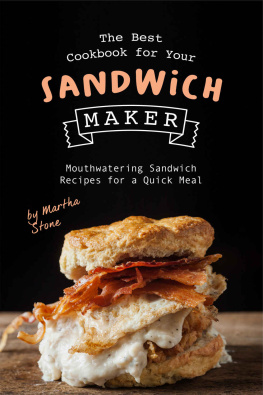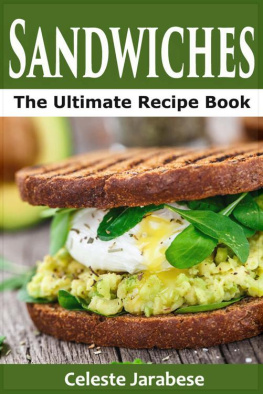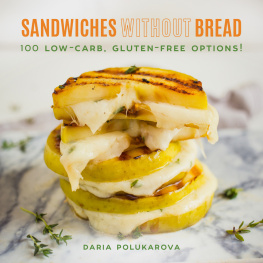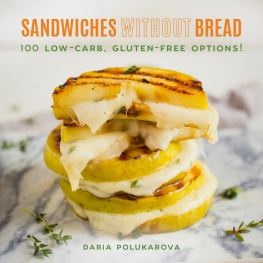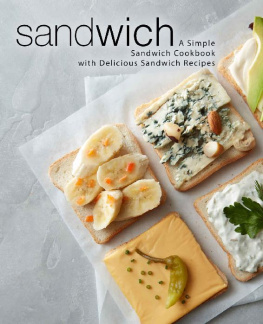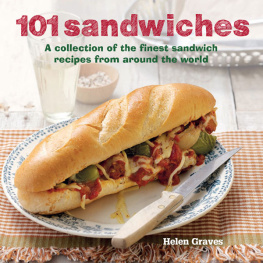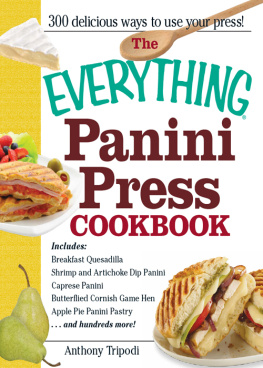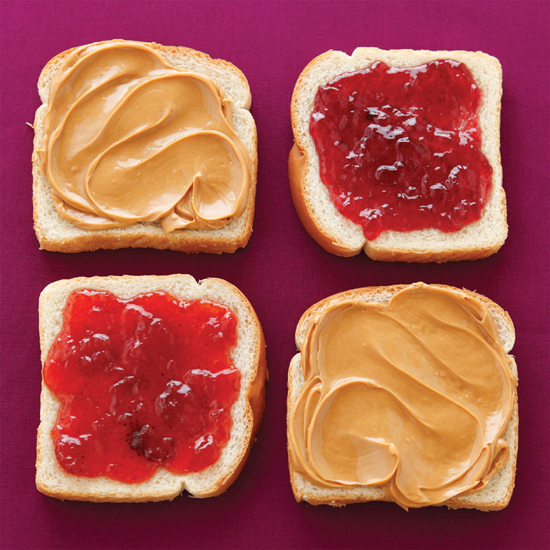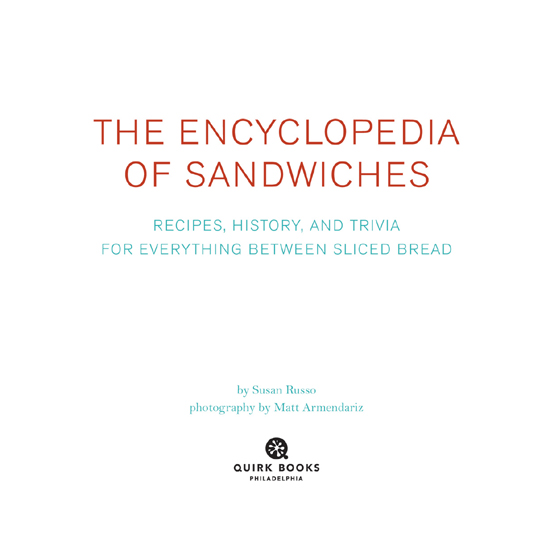Copyright 2010 by Quirk Productions, Inc.
All rights reserved. No part of this book may be reproduced in any form without written permission from the publisher.
Library of Congress Cataloging in Publication Number: 2010933869
eBook ISBN: 978-1-59474-701-4
ISBN: 978-1-59474-438-9
Designed by Jenny Kraemer
Production management by John J. McGurk
Photography by Matt Armendariz
Editorial assistance by Jane Morley and Alexandra Bitzer
Quirk Books
215 Church Street
Philadelphia, PA 19106
www.quirkbooks.com
v3.1
FOR MY DAD, who has proudly told every single
person in Rhode Island about this book.
FOR MY MOM, who has happily tested
every recipe in this book.
FOR MY HUSBAND, who has eaten every sandwich
in this book. Often more than once.
ENJOY EVERY SANDWICH.
Warren Zevon
Acknowledgments
Thanks to sandwich lovers everywhere.
Special thanks to Margaret McGuire, my editor. Shes smart, funny, creative, and patient, everything an editor should be. Many thanks to Matt Armendariz and Jenny Kraemer for making humble sandwiches look glamorous; the Quirk staff who helped make this book a reality; sandwich aficionados Jane Morley and Alexandra Bitzer for their research and editorial support; the readers of my website, Food Blogga, for their encouragement; Brad Walker of the Brown Hotel in Louisville, Kentucky, for sharing the hotels iconic Hot Brown sandwich; the Three Guys From Miami, Glenn Lindgren, Raul Musibay, and Jorge Castillo, for sharing their recipe for the Cuban Sandwich, first printed in their cookbook Three Guys From Miami Cook Cuban; Terry Thompson-Anderson, author of Cajun-Creole Cooking, and Kathy Shearer of Shearer Publishing, Fredericksburg, Texas, for allowing me to reprint Ms. Thompson-Andersons recipe for the New Orleans oyster loaf; Steve Lupo of Lupos Spiedies in Binghampton, New York, for teaching me about the spiedies history and for sharing tips on making them at home; the folks at Campanile Restaurant in Los Angelesin particular, Mark Peel, the executive cheffor sharing the recipe for an open-faced burrata sandwich; Jesse Goldstein, owner of Nashvilles famous Loveless Caf, for sharing their recipe for chicken salad; the Primanti Brothers for sharing their recipe for a homemade version of the classic Primanti; Jane Bitto of Evelyns Diner in Tiverton, Rhode Island, for sharing her recipe for the singular Chow Mein Sandwich; John Brunetto of Mona Lisa Italian Foods in San Diego for his tips on making a memorable Caprese sandwich; the good people at Venda Ravioli in Providence, Rhode Island, for sharing their recipe for Bresaola and Arugula Sandwich, and to Chris Spertini, in particular, for his time. And thanks to my recipe testers Zaira Avolos, Eilenn Anonical, Deborah Balint, Jayne Belz, Carrie Boyd, Sarah Caron, Susannah Chen, Mike DiEva, Leslie Frasier, Annie Gallo, Valerie Harrison, Elly Kafritsas, Michael Kindness, Laetitia Laure, Lisa Lawless, Deb Mahon, Hilary Marsfelder, Amy Morgan, Rachel Narins, Karen Padilla, Stacey Rittenberg, Kate Selner, Mike Stephens, Brianne Smith, and Kasia Wolny.
Thanks to my mom for always saying, Sure, honey, anything for you, every time I asked her to test a recipe. Thanks to my dad for being my most loyal fan. And thanks to my husband, Jeff, for eating more sandwiches in the course of a few months than he had in his entire lifetime. And for not complaining when his jeans got tight. I would have.
Introduction
A Tribute to the Greatest Invention since Sliced Bread
Hello, Sandwich Lovers!
Have you eaten a sandwich today? Odds are you have. Hundreds of millions of people across the globe do every single day.
Its not surprising. The simple combination of bread and filling is a remarkable culinary invention: its satisfying, fast, comforting, and portable. Not only do we love to eat sandwiches, but we also love to make them, talk about them, and gaze upon them. Entire books, television shows, and websites have been devoted to this modest food. Some people have traveled the world eating nothing but sandwiches. Others write poems about them.
Why are we so passionate? Because sandwiches typically have deep cultural, ethnic, and geographic roots. Think of the Vietnamese bahn mi, the Italian panino, and the American fluffernutter; each has its own delicious story, and we cherish those stories almost as much as the sandwiches themselves.
Sandwiches are among the most democratic of foods. Theyre perfect day or night. They can be a quick snack or a bona fide meal. Decadent or plain, six inches or six feet, sandwiches have always been honest, filling food. Theyre affordable yet nutritious. They can be eaten just about anywhere, including over the kitchen sink. And theyre gloriously unfussy.
Yet sandwich purists (yes, they exist, and if youre reading this, youre likely one of them), will argue that a sandwich isnt just a sandwich. It can be humble or high-brow. In the right hands, it can be a culinary pice de rsistance.
What Makes a Sandwich a Sandwich?
The Great Sandwich Debate
This hands-on staple has evolved from its humble beginnings to include a series of delicious and exclusive anomalies. Originally, a sandwich was any of a variety of fillings held together with two or more slices of bread. After years of tasty experimentation, the fillings now range from meat and cheese to French fries and spaghetti. And dont even get started on breadrolls and buns, sure, but what about waffles, biscuits, cakes, and cookies?
People are just as passionate about what can or cannot be a sandwich as they are about how to build one. In fact, the debate became so heated that, in 2006, it went to court in a food-chain lawsuit between Panera Bread Co. and Qdoba Mexican Grill. In the case, a Massachusetts court set the unfortunate precedent that burritos, quesadillas, wraps, and tacos are not legally part of our beloved sandwich family. Perhaps, in the years to come, these less-bready cousins will be legally allowed to join the venerated rank of sandwiches. But, for the purposes of this Encyclopedia of Sandwiches, a sandwich is defined as a variety of fillings snuggled lovingly between two sides or slices of leavened eatablesunless, of course, it is open-faced, in which case only one leavened surface is required. Yes, dear reader, this definition includes the likes of the Hamburger and the Hot Dog, thanks to their basic construction and historical categorization. And youll see such iconic sandwiches as the Classic Club, the Reuben, and the Sloppy Joe sharing space with forgotten gems like the Sandwich Loaf and quirky up-and-comers like the Muffinwich and the Banana Split Sandwich.
The Evolution of the Sandwich
From the Earl of Sandwich to Colonel Sanders
Our beloved snack has inauspicious roots. In 1762 in England, the fourth Earl of Sandwich, an inveterate gambler, demanded a handheld meal of meat placed between two slices of bread so that he wouldnt have to leave the gaming table for his repast. As Alan Davidson notes, the earl may not have been the first person to place food between two slices of bread, but he is responsible for igniting a culinary revolution that has gained momentum ever since.


